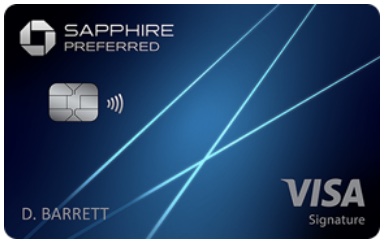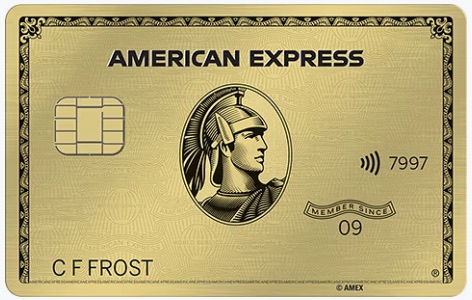by Daniel | Last Updated June 29th, 2023

We may earn a commission for purchases using our links, at no cost to you.
When it comes to mid-tier credit cards the American Express Gold Card and the Chase Sapphire Preferred Card are two credit cards I really like and are amongst the most talked about credit cards available today.
And there’s a good reason for this, both cards offer a generous sign-up bonus that can be worth well over $1,000.
They also both offer the ability to earn yourself plenty of points through a variety of different categories which can end up being really quite valuable.
So in this article, I’m going to review and compare both of these credit cards and break down in detail the strengths and weaknesses that each card has. And then at the end of this article, I’ll give you my opinion on which card is the best value.
Are These Cards Good For You?
Now before I get into the finer details about both of these credit cards it’s worth considering if either one of them might be a good option for you and your situation.
The first thing to know about these cards is that they both have an annual fee.
Starting with the cheaper of the two cards, the Chase Sapphire Preferred you are looking at an annual fee of just $95.
Then with the American Express Gold Card, the annual fee is quite a bit more coming in at $250, or about 2.5x more than the Chase Sapphire Preferred card.
Now if don’t like the idea of paying an annual fee, both of these cards offer more than enough value to offset the cost of the annual fee and leave you with quite a lot of extra value.
As I will show you later in this video, if you just follow a few simple steps it is actually quite easy to achieve.
Another thing to know about both of these credit cards is that a large proportion of the value on offer is travel related.
What Is The Signup Bonus Worth?
So let’s start off by answering one of the more obvious questions which is, how much the sign-up bonus is worth with each card?

Starting first with the Chase Sapphire Preferred card, it is currently possible to receive 60,000 bonus points after spending $4,000 on purchases within the first 3 months of opening the account.
And when redeeming the points through Chase Ultimate Rewards, they are worth 1.25 cents per point, which provides you a value of $750.
Now as with both of these cards, you will receive the most value by transferring the points to one of the related travel partners.
And currently, the Chase Sapphire Preferred card has 11 different airline partners and 3 hotel partners which all present a transfer value of 1:1.
So let’s just take a quick look at how you can receive over $1,000 in value just by transferring the points to one of the travel partners.
And starting with the World Of Hyatt website, which is one of the hotel travel partners of this card, I have found a hotel in Fiji called the Nanuku Resort which has a suite for $650, so for two nights it would cost you $1,300.

Now if you transfer your points to the World Of Hyatt, which can be done at a rate of 1:1 it is possible to book the same room for just 25,000 points per night, so for two nights that’s 50,000 points.

This provides you with a value of 2.6 cents per point or $1,300, which is more than twice as much as the points are worth when redeeming them through Chase Ultimate rewards.

Now with the American Express Gold Card, it is possible to earn 60,000 Membership Rewards Points after you spend $4,000 on purchases within the first 6 months of opening the account.
And even though it is the same amount as the Preferred card, you actually have twice the amount of time to reach the spending requirements, which can be helpful if you don’t spend a lot on your credit card.
Now Amex Membership Rewards Points are worth up to 1 cent per point when they are redeemed through American Express Travel which provides you with a value of $600.
So not quite as much as the $750 in value, you receive for the Chase Sapphire Preferred card.
And currently, Amex has 17 airline partners that provide a transfer value of 1:1, except for JetBlue which provides a transfer value of 2.5:2, and then AeroMexico which provides a transfer value of 1:1.6
Then there are 3 different hotel partners that offer a transfer value of 1:1 except for Hilton Honors which offers a value of 1:2.
So let’s just take a look at the Hilton Honors website, and here I have found a Hotel in NYC called the Conrad New York Downtown, and for the dates I have selected it is $855 a night, which is pretty expensive, and if you use Hilton Points it will cost 90,000 points.

Now seeing that it is possible to transfer Membership Reward Points to Hilton Points at a ratio of 1:2, it will only cost you 45,000 Membership Rewards Points to book this room.
This works out to be a value of 1.9 cents per point, which is almost twice as much as you will receive when using points through Amextravel.com
And if you multiply 1.9 times the 60,000 point signup bonus you are looking at a value of $1,140.
Benefits And Perks Of Each Card
Now besides the decent-sized sign-up bonus that is currently on offer with each of these cards, there are also a few benefits and perks that provide you with even more value.

Starting first with the Chase Sapphire Preferred card it is possible to receive a $50 statement credit each year for hotel bookings that are made through Chase Ultimate Rewards.
And this effectively brings the annual fee down to an even more reasonable $45.

Each year of card ownership Chase will actually give you back bonus points that are equal to 10% of your total spend.
So if you spend $15,000 on the card over the course of a year, Chase will give you 1,500 points.
Now there are also a few partner benefits that come with this card which include the following:
A complimentary 6-month Instacart+ membership that is worth approximately $50.
This benefit also provides you with a $15 statement credit each quarter.
You will then receive a complimentary 12-month DashPass Subscription that has a value of $96.
And finally, it is possible to receive a $10 monthly statement credit from Gopuff.

Now with the Amex Gold card, you actually get quite a few more benefits than what you get with the Chase Sapphire Preferred card, and so you should seeing that it costs $155 more for the annual fee.
So first up there is a $120 Dining Credit that is provided to you in $10 monthly statement credits.
And this can be used at the following locations:
- Select Shake Shack locations
- The Cheesecake Factory
- Wine.com
- Gold Belly
- Milk Bar
Along with this, there is $120 in Uber Cash that can be used towards either Uber Eats or Uber rides.
And this is also provided to you in $10 monthly allotments.

And finally, there is access to The Hotel Collection, and this provides you with a $100 experience credit that can be used during your stay, as long as the booking is for 2 nights or more.
So if you know you will use these benefits in full, it will almost cover the total annual cost of the card.
How Can You Earn Points?
Now both of these cards offer quite a descent array of points earning options from a range of different categories.

Starting first with the Chase Sapphire Preferred Card it is possible to earn points from the following categories:
- 5x points on travel-related purchases that are made through Chase Ultimate Rewards
- 5x points on Lyft rides
- 3x points at restaurants, eligible delivery services, and takeout
- 3x points for online grocery purchases
- 3x points on select streaming services
- And then all other purchases will earn you 1 point per dollar spent

Then with the Amex Gold card, it is possible to earn points from the following categories:
- 4x points at restaurants worldwide, and this includes takeout and delivery services
- 4x points at US supermarkets up to a total spend amount of $25,000 each year
- 3x points on flights that are booked directly with an airline or through amextravel.com
- And then all other purchases will earn you 1 point per dollar spent
So both cards offer an impressive range of options for earning points.
With the Chase Sapphire Preferred card, you will be able to earn slightly higher points on travel compared to the Amex Gold card, whereas the Amex Gold card offers a better opportunity for earning points from restaurants and grocery store purchases.
So just based on this, if you have a good idea of where you spend most of your money, it shouldn’t be too hard to figure out which card will offer you the most points earning potential.
What Insurance Coverage Do You Receive?
Now both of these cards come with quite an impressive lineup of insurance coverage, most of which covers travel or purchase-related insurance.
Both cards offer Auto Rental Insurance.
With the Amex Gold card, it is secondary coverage on covers up to $50,000.
Then with the Chase Sapphire Preferred card, the coverage is primary insurance and provides reimbursement up to the cash value of most vehicles for theft and collision damage.

There is Trip Delay Insurance offered with both cards.
The Amex Gold card provides you with up to $300 per trip if it is delayed for more than 12 hours, and it is possible to make up to 2 claims in a 12-month period.
With the Chase Sapphire Preferred card, it is possible to receive up to $500 per ticket for you and your family if your travel happens to be delayed for more than 12 hours.

Both cards offer an Extended Warranty, with the Amex Gold card you will receive 1 additional year of coverage on warranties that are 5 years or less.
Then with the Case Sapphire Preferred card, you will receive 1 additional year of coverage on warranties that are 3 years or less.
Both cards also offer Purchase Protection.
With the Amex Gold card, you will receive up to 90 days of coverage on new purchases that are either accidentally damaged or stolen, and this covers up to $1,000 per occurrence and a total of $50,000 per year,
Then with the Chase Sapphire Preferred card, you will receive 120 days of coverage against damage or theft.
And this provides you with up to $500 per claim and a total of $50,000 per account.
Now only the Amex Gold card offers a Baggage Insurance Plan.
This basically covers you for up to $1,250 for carry-on luggage and $500 for checked baggage if it happens to be damaged or lost.

Then only the Chase Sapphire Preferred card offers the following coverage:
- Baggage Delay Insurance which covers up to $100 per day for up to 5 days if your luggage happens to be delayed for more than 6 hours by a passenger carrier.
- Trip Cancellation/Interruption Insurance which covers up to $10,000 per person and $20,000 per trip.
Final Thoughts
Ok so that pretty much covers everything there is to know about both of these cards and as you can see they both offer a comparable sign-up bonus, points-earning potential and insurance coverage.
If you take into account the credits that are offered with each card and use all of them, the Chase Sapphire Preferred card will end up costing you $45 a year as it comes with a $50 statement credit for hotel bookings.
Whereas with the Amex Gold card, you will only be paying $10 a year, as it comes with a $120 Dining Credit and $120 in Uber Cash.
So technically speaking the Amex Gold card is actually cheaper on an annual basis than the Chase Sapphire Preferred card, but does this mean it is a better card?
Well, not necessarily, like a lot of things in life, it really depends on what your situation is and where you will actually find the most value from.
I have personally had both of these cards and liked them a lot, but if I could only choose one I would have to take the Chase Sapphire Preferred card as both cards are very similar in reality, the main thing for my situation is that the Chase Card is a Visa card, which is accepted at more places overseas than the Amex card, and because I travel all year round that suits me.
If I didn’t travel so much I would be perfectly happy with the Amex Gold card.
But I’d be interested to know what card you think is the better card and why? Let me know in the comments section below.
Now if you found this article interesting make sure to check out my other article that reveals what the Ultimate Credit Card is for 2023.
